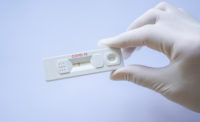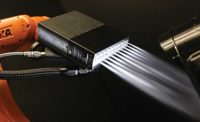Adhesives come in several forms: thin liquids, thick pastes, films, powders, tapes or solids that must be melted. They can be designed with a wide range of strengths, from weak temporary adhesives for holding parts in place to high-strength structural formulations.
Important properties that must be considered when choosing an adhesive include cure rate, gap-filling capability, tensile shear strength, peel strength, impact resistance, load-bearing capability, heat and cold resistance, fluid resistance, and health and safety issues.
Although numerous types of adhesives are used in product assembly, many are what we classify as structural or engineering adhesives. The number of adhesives for load-bearing applications is somewhat limited. Highly cross-linked structures are necessary to support loads.
The most important types of these adhesives are anaerobics, epoxies, reactive acrylics, UV or light-cured adhesives, polyurethanes, special formulations of cyanoacrylates, and reactive hot-melt polyurethanes (RHMUs).
Anaerobics are one-component liquids that cure rapidly when confined between two surfaces. Their most well-known application is to replace lock washers in threaded fastener assemblies, where they fulfill the dual function of locking and sealing the assembly. Frequently referred to as liquid lock washers, anaerobics adhere strongly to metal surfaces and prevent loosening from vibration. They also completely fill the voids in a threaded assembly and protect it against corrosion.
Epoxies have been the major structural adhesive for bonding metals and composites in aerospace, automotive and other industries. Curing to hard infusible resins that bond a wide range of metals, epoxies have excellent heat and environmental resistance.
Reactive acrylics are two-component, 100 percent reactive adhesives based on methacrylate and acrylate monomers that are toughened with dissolved rubbers. They are cured either by using a surface primer or by mixing two components together. These adhesives are useful in demanding plastic- and metal-bonding applications, where fixture times of a few minutes and strong, impact-resistant bonds are required. They often compete effectively with epoxies.
UV adhesives use acrylic or special epoxy monomers to bond materials in seconds using the power of ultraviolet or visible light. They are valuable in high-volume or critical applications, such as medical device assembly.
Polyurethanes are one- or two-component adhesives that cure to tough, flexible adhesives. One-component formulations react with atmospheric moisture, or they can be misted with sprayed water. Two-component formulations must be mixed thoroughly before use. The largest application for polyurethanes is the bonding and sealing of automotive windshields.
Cyanoacrylates were traditionally not considered as structural adhesives because of their thermoplastic nature, brittleness and limited thermal resistance. However, new formulations toughened with elastomers have true structural properties. Their use is often limited to relatively small parts because of their high cost.
RHMUs are relatively new. These one-component adhesives are applied molten, like conventional hot-melt adhesives, with virtually instant fixturing. They then cure by reaction with atmospheric moisture to yield a cross-linked polymer.



